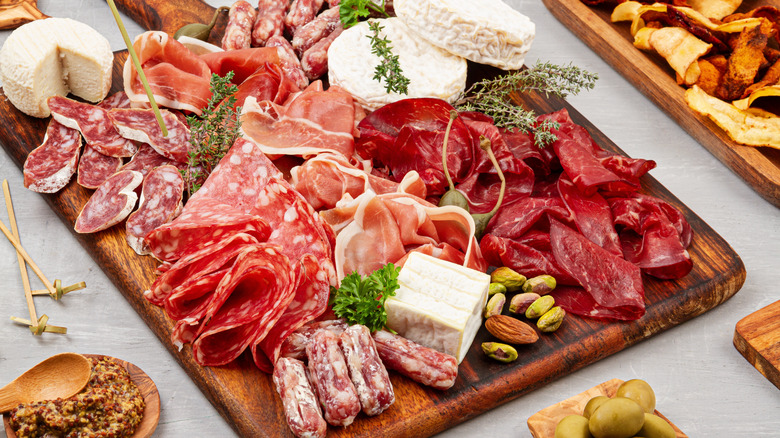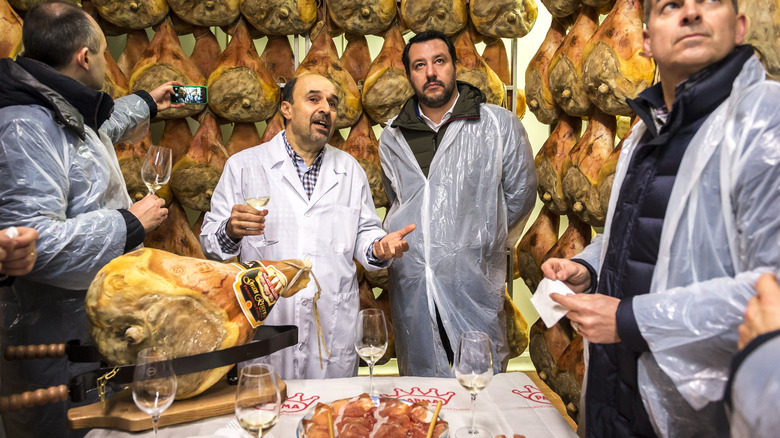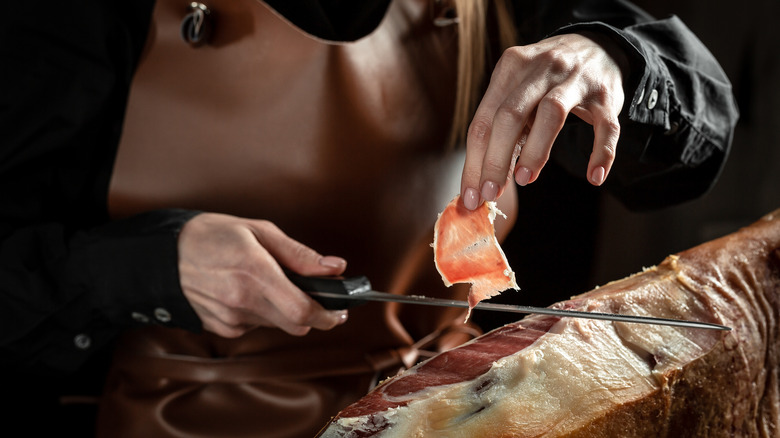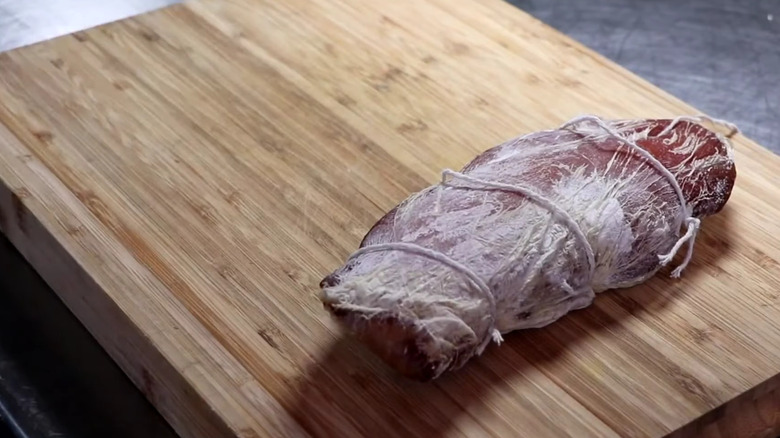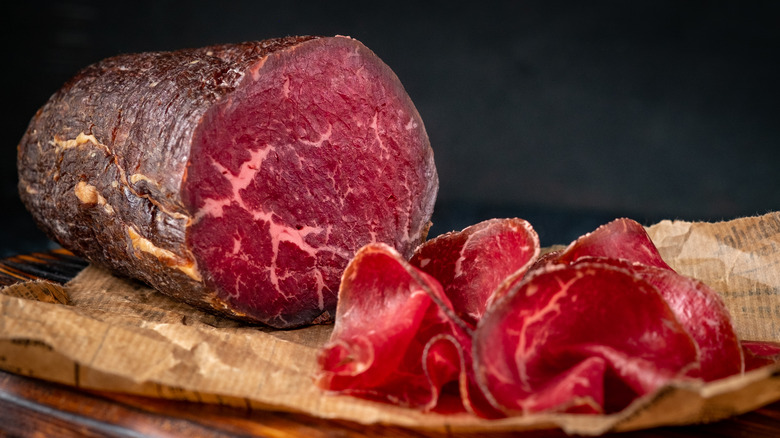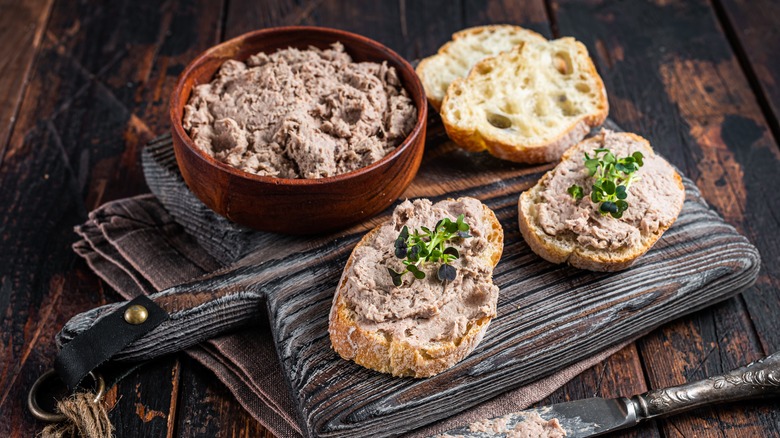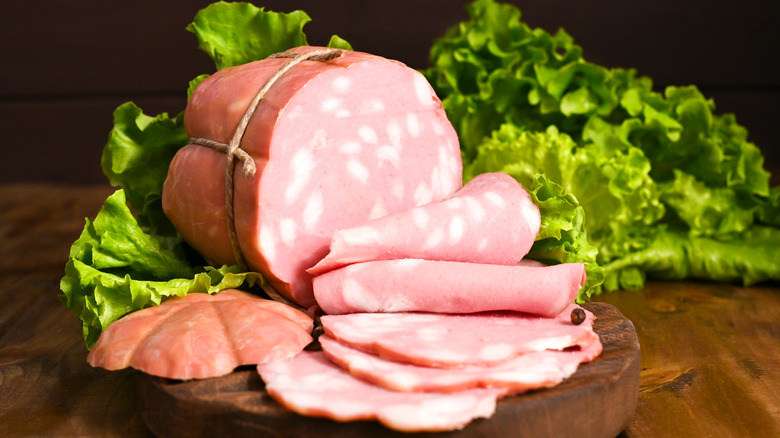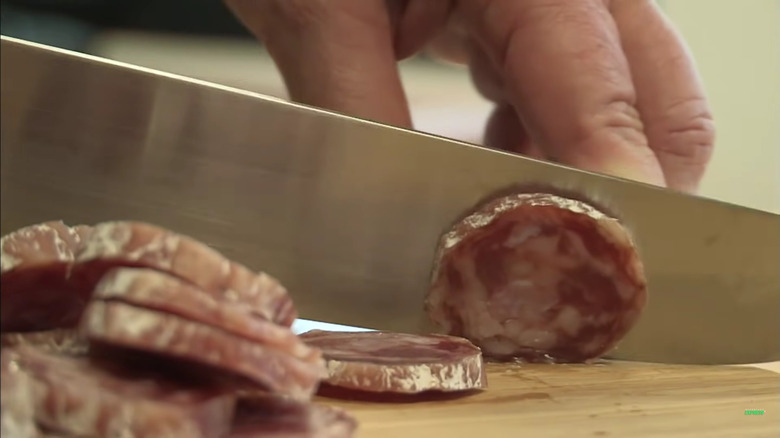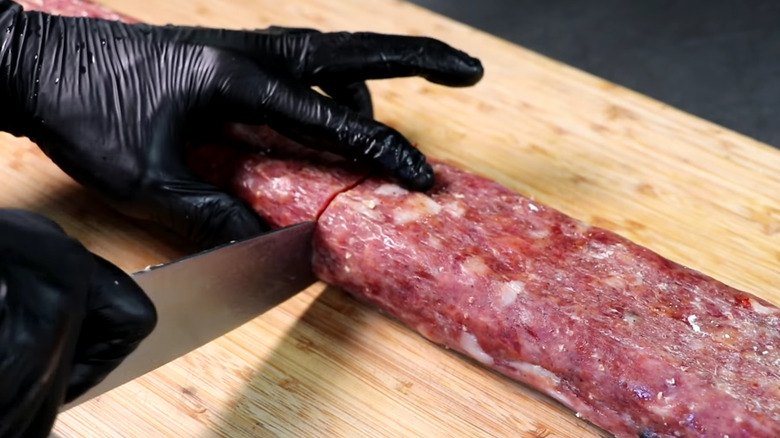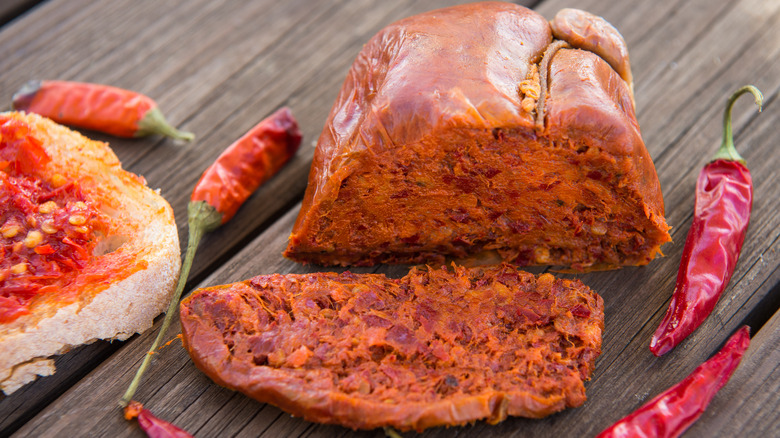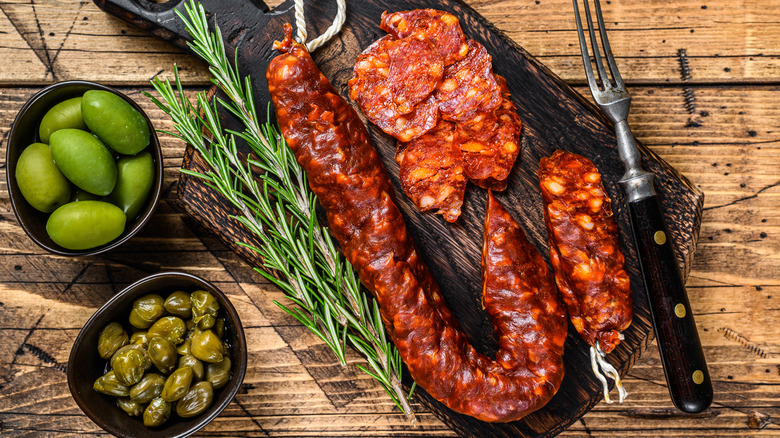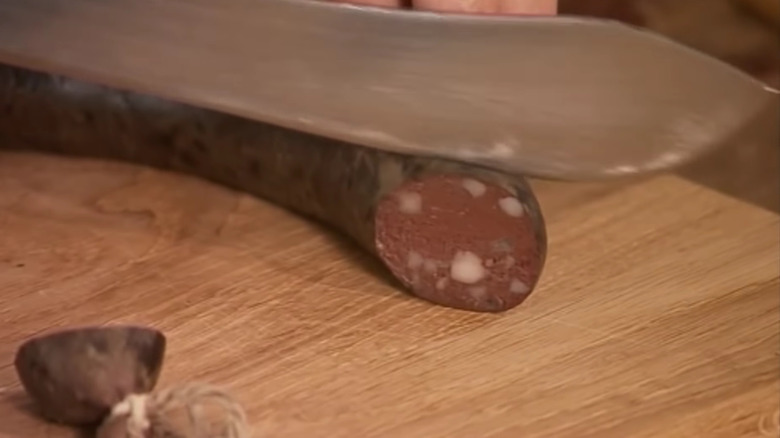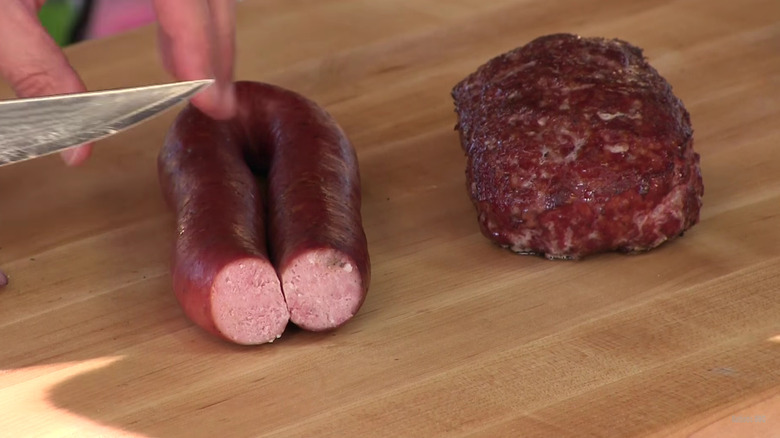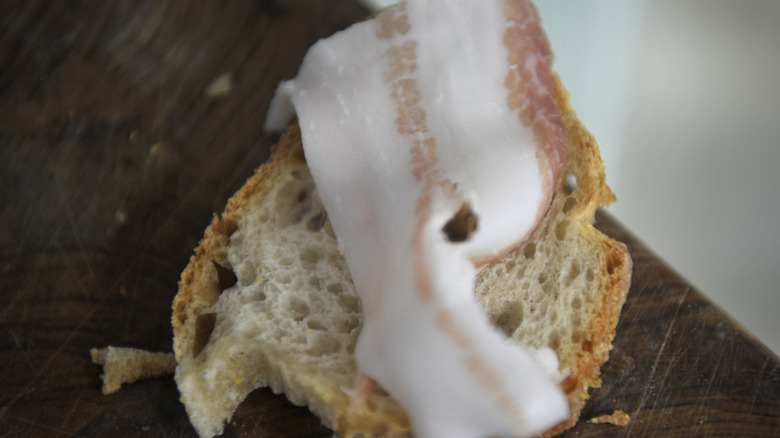The Best Types Of Meat To Use For A Charcuterie Board
As reported by Insider, charcuterie boards have found a new lease on life in the 21st century, largely thanks to their artisanal nature and photographic appearances. Charcuterie board influencers — yes that's a thing — have flooded social media with tips and tricks on how to present the most aesthetically pleasing board; there are even a few books on the topic, too (via Goodreads).
Yet, creating a fantastic charcuterie board relies on substance as well as style. After all, there is little opportunity for substandard products to hide when being eaten in such a stripped-back setting (per The Guardian). When attempting to build the perfect charcuterie board, a range of high-quality products must be sought out, especially when it comes to meat.
Not only must this meat — known as charcuterie — be of high quality, but it must also be of a varied nature. Having an array of meat types, flavors, and textures present will ensure that the eating experience is diverse and exciting. Fortunately, great charcuterie can come from anywhere in the world, with the old bastions of central Europe being joined by other producers, such as the United States, the United Kingdom, and China, to name a few. More options mean harder choices, so we have highlighted the best types of meat to include in your next charcuterie board, whether you want a fun evening meal or to be the next charcuterie influencer.
Prosciutto di Parma
If product quality is everything when it comes to charcuterie, you cannot go wrong with prosciutto di Parma. This notoriously silky and salty ham is the epitome of how the intersection between historic, artisanal food practices and tight modern-day regulation results in a product of unparalleled quality.
As highlighted by the Consorzio del Prosciutto di Parma, a group of producers that make the specialty hams, the product can trace its history back to the Ancient Roman Empire. During that time, Cato the "Censor" mentioned Parma's exquisite hams were air-cured and flavorful.
Today, prosciutto is made in nearly the same way, produced using only sea salt, the surrounding air, and a long curing time (via Eataly). Tight regulation by the consortium means that only the hind legs from free-roaming, heritage breeds of pigs that are fed on a special diet can be used to make prosciutto di Parma. These regulations, guaranteed by the European Union's Protected Designation of Origin certification, should ensure that the prosciutto's quality never wavers. However, the Independent did find some variations in quality between products, with freshly carved ham being superior to the pre-packaged variety.
Prosciutto di Parma is an absolute must-have on every charcuterie board thanks to its status as the king of cured meats. Its sweet, salty taste and creamy texture will be a familiar favorite of all those partaking.
Jamón ibérico
The only serious contender to prosciutto di Parma's throne is jamón Ibérico, the famous, acorn-laced ham that comes from Spain's ancient, intricately interdependent agroforestry system, the dehesa (via National Geographic). Fortunately, the two hams differ so much in texture and taste that having both on the same charcuterie board will not pose an issue.
The ultimate grade of this ham is the black label, which is awarded when the pigs are 100% purebred, allowed to roam freely on the dehesa, and only eat a diet of wild acorns (via the Independent). The ham produced by these animals is sensational. It's known to almost melt on the tongue thanks to the bucketloads of umami it boasts. The flavor profile finishes with a nutty, floral aftertaste.
Unfortunately, not all pigs are destined to reach the acclaimed heights of black label jamón Ibérico de bellota. There are three lesser grades produced in Spain, with each being more affordable than the last.
Indeed, such is the demand for cheaper yet still distinctly Iberian ham that some American companies have begun importing the famous blackfoot pigs, as reported by The Guardian. This ensures that whatever your budget, you should be able to add this unique and iconic ham to your charcuterie board.
Guanciale
Guanciale is not a cured meat that can rival the likes of jamón Ibérico for global renown. In fact, there are probably not many people outside of the product's native Italy that have even heard of it. Yet, guanciale can compete with its more famous peers in the most important department: flavor.
Billed as a fattier version of pancetta, it should come as little surprise that guanciale packs a lot of rich, savory flavor (via Salon). Guanciale is made from pigs' cheeks, which are salted for a week before being cured. This means that the product, like other cured meats, is completely safe to eat uncooked, even though many frequently choose to fry it.
Including thin strips of guanciale on a charcuterie board is a great way to offer guests something new and unfamiliar, which is one of the attractions of charcuterie boards. To make things even easier, guanciale should not prove too challenging for most palates; if your guests like bacon, you can rest assured that they will love guanciale.
Bresaola
Many charcuterie boards focus on pig meat, and rightly so; the range of flavors and textures that can arise from this one animal is simply astounding. However, variation is the spice of life, and this is no truer than when it comes to charcuterie boards. Using cured meats from different animals instantly imbues your board with a range of flavors and textures. As explained by Fine Dining Lovers, bresaola is a type of beef made with cured topside, silverside, and eye-round cuts. It is one of the most prevalent non-pork charcuterie options, a fact attested to by the product's healthy export statistics highlighted by Assica (per Italianfood.net).
Bresaola is not only distinguished by being a beef product but also by its ruby red color and aromatic, spiced flavor. The latter is largely thanks to a spicing process that uses robust flavorings, some even as bold as nutmeg (per Volpi Foods). These spices are massaged into the meat, which lends it a seasoned dimension not frequently seen in whole-muscle charcuterie cuts.
While native to Italy, bresaola is increasingly being produced in the United States. In The New York Times, food critic Florence Fabricant highlights Brooklyn Cured's spicy bresaola, which is flavored with spicy Calabrian chiles, as an excellent American-produced charcuterie option.
Rillettes
The two major categories of meat present in charcuterie boards are whole muscle cuts, such as prosciutto di Parma, and salamis like Saucisson Sec. However, spreadable meats, in the form of pâtés, rillettes, and 'nduja can also form an important part of charcuterie boards by offering an entirely different texture.
Pâté may be the most common form of spreadable meat, but that does not mean it is the best. Many people, including French butcher Emmanuel Ligneul, believe rillettes are of superior quality. "It's not pâté," he said in an interview with The Guardian. "It's the best chunks of pork, shoulder, and leg, cut into small pieces and cooked in their own fat in a large vat. You can't use cheap cuts, and the meat isn't minced or processed, just pulled and pressed."
Dr. Neil Buttery, a food industry professional who has been featured on Channel 4, Radio 4, and in The Telegraph, notes in his blog, British Food: A History, that rillettes is also commonly made with less popular meats such as rabbit. Consequently, a small pot of rillettes provides a delicious and unimposing means of introducing slightly more challenging meats to your charcuterie board.
Mortadella
The history of mortadella is one marked by peaks and troughs. As reported by The New York Times in 2000, this Italian cured sausage was banned from American soil between 1967 and 2000 due to an outbreak of African swine fever. Mortadella's return, as highlighted by the publication, was a joyful one, and the salami has continued to grow in popularity over the last two decades. It has been frequently championed by notable figures in the food industry, such as ex-Bon Appétit star Alex Delany, who seems to find an excuse to add a slice to absolutely anything.
For British audiences, mortadella's appearance has proven to be a barrier to consumption, as conceded by Enzo Mirto, cofounder of the London restaurant Officina 00. "While mortadella's appearance might look unsophisticated," he said in an interview with Pellicle Magazine, "actually, its preparation requires a lot of different phases: sourcing, mincing, seasoning with many spices, molding and cooking with 72 hours smoking at very low temperature, adding wood to the furnace piece by piece, which is what gives it the special pinkish color."
Pellicle also highlights the time-consuming process of making mortadella, which includes mixing and grinding meat, fat, spices, and ice a total of five times to achieve the product's smooth texture. This iconic characteristic, alongside its unique blended flavor, makes it a great contribution to charcuterie boards.
Saucisson sec
When you think of charcuterie, you might picture French saucisson sec's iconic white casing and fat-dappled interior. It is, to put it mildly, a classic charcuterie choice beloved for its punchy garlic and pepper flavor (per Olympia Provisions). There are many regional varieties of saucisson, each of which includes unique ingredients. For example, saucisson d'Alsace is flavored with spices like clove and cinnamon, while saucisson aux noisette has hazelnuts.
Even though the flavor may vary, traditional versions of saucisson sec usually have a natural casing made of hog intestines (per Mon Panier Latin). The casing is of extra importance for the production of saucisson sec, as it provides the sausage with shape and structure. It also allows the pork meat to be fermented by a strain of acid-producing bacteria called Lactobacillus. Meat Science reports that the acid produced by this bacteria is one of the things that gives the salami such a long shelf life. Il Porcellino Salumi adds that the layer of white mold that covers the salami also helps protect the meat from harmful strains of bacteria.
Saucisson sec's iconic, chewy texture and captivating taste mark it as an absolute must for all charcuterie boards. However, be sure to only purchase cured versions of this salami, which have a far superior taste when compared to cooked saucisson sec (via The New York Times).
Soppressata
Bottega di Calabria highlights soppressata as the premier salami in Calabria. This is no easy feat when you consider that this southwestern region of Italy is also home to other globally renowned salamis, such as 'nduja and capocollo. While both these salamis are excellent, soppressata is in a league of its own. This is partly because only the highest quality lean cuts of meat are used in its preparation (per Bottega di Calabria).
Aside from influencing the taste, the use of premier lean cuts also gives this salami a distinct, coarse texture (per Carnivore Club). There are three main types of soppressata, each made with a different spice. White soppressata is made with black pepper, sweet soppressata has red pepper, and spicy soppressata includes hot pepper. Each of these will serve as an excellent lean meat option for your charcuterie board, providing respite from the fat-heavy options previously mentioned. The common consensus is that when served on a charcuterie board, this salami should be cut into thick slices to better demonstrate its coarse texture.
'Nduja
Like soppressata, 'nduja is another Calabrian salami that has taken the world by storm. Here, however, is where the similarities stop. While soppressata is traditionally made with premium, lean cuts, 'nduja has always been a food for peasants (per Great Italian Chefs). It is made from the cheapest bits of pork available, including offal, and flavored with spicy Calabrian chiles.
The thing that makes 'nduja stand out from other salamis is its texture. The salami is spreadable like pâté and can be used in a variety of culinary techniques. This, above all else, is what has led this regional delicacy to become a common part of restaurant, bistro, and café menus around the world (per Sauce Magazine).
When it comes to charcuterie boards, 'nduja still manages to find a way to shine, thanks to its spicy flavor profile. The only caveat is that when adding 'nduja to a charcuterie board, it is absolutely vital that you provide something on which to spread it. The classic choice is bread, although crackers or even naan will suffice.
Spanish chorizo
If 'nduja represents the new wave of globally popular spiced salami, its predecessor is undoubtedly chorizo. Great British Chefs reports that this cured meat has been created under various guises in Spain for centuries. However, the undeniably Spanish product that we know and love today owes a large part of its iconic taste and crimson appearance to smoked paprika. This smoky spice only came to the country during Spain's colonization of the Americas.
There are regional flavorings that also play a part in the taste of chorizo. Chorizo produced in Spain's northern Basque region will nearly always feature choricero peppers, as reported by Edible Idaho. In Mexico, chorizo is made with Mexican chili peppers. (via Fine Dining Lovers). It should be noted that Mexican chorizo is raw and must be cooked; therefore, it's better to stick with Spanish chorizo for your charcuterie board.
As charcuterie, Spanish chorizo combines 'nduja's enticing flavor profile with a more classic salami texture. It is a very common and popular addition to most charcuterie boards thanks to its widespread availability (via Euro Meat News).
Black pudding
Black pudding, or blood sausage, is made from pig's blood, spices, and oats or barley. According to British Charcuterie Live, the sausage is traditionally made in communities that rear pigs for slaughter. Originally, this was because animals were too valuable of a food source and no part should go to waste. However, in the modern day, black pudding is the perfect example of how items that are undesirable foodstuffs alone can be transformed into a delicious delicacy with a little time and effort.
Black pudding has been made globally for centuries as attested to by its reference in Homer's ancient poem "Odyssey" (per Fine Dining Lovers). However, it is most popular in England, where the blood sausage is an integral part of a full English breakfast (per Insider). Yet, black pudding need not be pigeonholed into being solely a breakfast product. When used properly, it can bring a unique, earthy flavor to charcuterie boards.
While black pudding can be an exciting addition to charcuterie boards, the fact that it's made from blood and cereals — with no meat being present — means that black pudding itself is not technically charcuterie. This may lead some purists to object to its presence on a charcuterie board; however, we believe black pudding's addictively savory taste more than makes up for this technicality.
Smoked kielbasa
Kielbasa can loosely be defined as any sausage made in Poland or using Polish techniques and recipes, as noted by MasterClass. Of course, by its very nature, this classification ignores all the numerous intricacies and variations found in kielbasa across Polish cuisine. One such variation is smoked kielbasa, which is usually made with a cut of pork that has been hot-smoked for several hours (per Great British Chefs).
As the Michelin Guide notes, meats such as kielbasa add variation to your charcuterie board by providing smoky notes that cannot be found in other types of cured meat. However, it is advisable to only include one or two smoked meats on a charcuterie board, as the smoky flavor can soon overwhelm your palate and mask the flavors of other proteins (per First Post).
Including a whole smoked kielbasa can also contribute to another key facet of charcuterie boards — interaction. By having a piece of meat that guests must cut for themselves and others, you instantly create an environment that facilitates conversation, interaction, and enjoyment, as explained by The National Lottery Community Fund.
Lardo
Lardo is pig fat that has been cured through salting or smoking, which enables it to be stored and cut like a salami (per La Cucina Italiana). According to The Guardian, lardo has not always been popular, as recent generations have largely avoided animal fats due to health concerns regarding saturated fats.
As opinions on lardo and other animal fats change, they have become more widely utilized by chefs. The rich food is now featured in a variety of dishes, as typified by chef Marianne Lumb. "I think it's so popular in my kitchen because it is so versatile," she said in an interview with The Guardian. "We introduced lardo di colonnata in our canapés by slicing it very thinly and using it instead of rice paper to wrap mint, radish, and carrots. I also use it on a scallop dish, again sliced very thinly, and I gently blowtorch it so it goes translucent. It offers delicious flavor and also a real visual treat to a dish."
By its nature, lardo is extremely fatty and rich, so it is best served as wafer-thin slices atop warm bread (via Fine Dining Lovers). Be sure to have a pepper grinder by your charcuterie board because freshly ground black pepper is the perfect topping for this delicacy.
